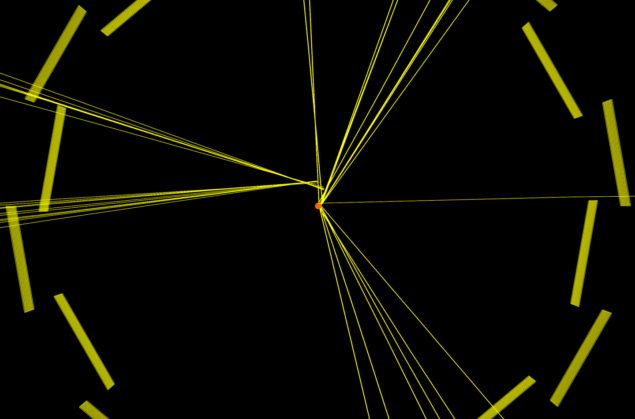
Searches for new physics at high-energy colliders traditionally target heavy new particles with short lifetimes. These searches determine detector design, data acquisition and analysis methods. However, there could be new long-lived particles (LLPs) which travel through the detectors without decaying, either because they are light or have small couplings. Searches for LLPs have been going on at the LHC since the start of data taking, and at previous colliders, but they are attracting increasing interest in recent times, more so in light of the lack of new particles discovered in more mainstream searches.
Detecting LLPs at the LHC experiments requires a paradigm shift with respect to the usual data-analysis and trigger strategies. To that end, more than 200 experimentalists and theorists met online from 16 to 19 November for the eighth workshop of the LHC LLP community.
Dark quarks would undergo fragmentation and hadronisation, resulting in “dark showers”
Strong theoretical motivations underpin searches for LLPs. For example, dark matter could be part of a larger dark sector, parallel to the Standard Model (SM), with new particles and interactions. If dark quarks could be produced at the LHC, they would undergo fragmentation and hadronisation in the dark sector resulting in characteristic “dark showers” — one of the focuses of the workshop. Collider signatures for dark showers depend on the fraction of unstable particles they contain and their lifetime, with a range of categories presenting their own analysis challenges: QCD-like jets, semi-visible jets, emerging jets, and displaced vertices with missing transverse energy. Delegates agreed on the importance of connecting collider-level searches for dark showers with astrophysical and cosmological scales. In a similar spirit of collaboration across communities, a joint session with the HEP Software Foundation focused on triggering and reconstruction software for dedicated LLP detectors.
Heavy neutral leptons
The discovery of heavy neutral leptons (HNLs) could address different open questions of the SM. For example, neutrinos are expected to be left-handed and massless in the SM, but oscillate between flavours as their wavefunction evolves, providing evidence for as-yet immeasurably small masses. One way to fix this problem is to complete the field pattern of the SM with right-handed HNLs. The number and other characteristics of HNLs depend on the model considered, but in many cases HNLs are long-lived and connect to other important questions of the SM, such as dark matter and the baryon asymmetry of the universe. There are many ongoing searches for HNLs at the LHC and many more proposed elsewhere. During the November workshop the discussion touched on different models and simulations, reviewing what is available and what is needed for the different signal benchmarks.
Another focus was the reinterpretation of previous LLP searches. Recasting public results is common practice at the LHC and a good way to increase physics impact, but reinterpreting LLP searches is more difficult than prompt searches due to the use of non-standard selections and analysis-specific objects.
The latest results from CERN experiments were presented. ATLAS reported the first LHC search for sleptons using displaced-lepton final states, greatly improving sensitivity compared to LEP. CMS presented a search for strongly interacting massive particles with trackless jets, and a search for long-lived particles decaying to jets with displaced vertices. LHCb reported searches for low -mass di-muon resonances and a search for heavy neutrinos in the decay of a W boson into two muons and a jet, and the NA62 experiment at CERN’s SPS presented a search for π0 decays to invisible particles. These results bring important new constraints on the properties and parameters of LLP models.
Dedicated detectors
A series of dedicated LLP detectors at CERN — including the Forward Physics Facility for the HL-LHC, the CMS forward detector, FASER, Codex-b and Codex-ß, MilliQan, MoEDAL-MAPP, MATHUSLA, ANUBIS, SND@LHC, and FORMOSA – are in different stages between proposal and operation. These additional detectors, located at various distances from the LHC experiments, have diverse strengths: some, like MilliQan, look for specific particles (milli-charged particles, in that case), whereas others, like Mathusla, offer a very low background environment in which to search for neutral LLPs. These complementary efforts will, in the near future, provide all the different pieces needed to build the most complete picture possible of a variety of LLP searches, from axion-like particles to exotic Higgs decays, potentially opening the door to a dark sector.
ATLAS reported the first LHC search for sleptons using displaced-lepton final states
The workshop featured a dedicated session on future colliders for the first time. Designing these experiments with LLPs in mind would radically boost discovery chances. Key considerations will be tracking and the tracking volume, timing information, trigger and DAQ, as well as potential additional instrumentation in tunnels or using the experimental caverns.
Together with the range of new results presented and many more in the pipeline, the 2020 LLP workshop was representative of a vibrant research community, constantly pushing the “lifetime frontier”.





